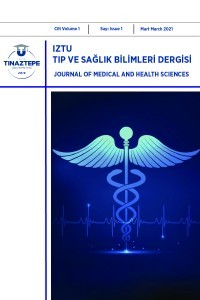Akran Eğitimi ile Meme Kanseri Farkındalık Eğitimi Alan Sağlık Bilimleri Öğrencilerinin Bilgi ve Davranış Düzeyleri
Akran eğitimi, Meme kanseri farkındalığı, Sağlık Bilimleri
Knowledge and Behavioral Levels of Health Sciences Students Who Received Breast Cancer Awareness Training with Peer Education
Peer education, Breast cancer awareness, Health sciences,
___
- Malak, A. T., Dicle, A. (2007). Assessing the efficacy of a peer education model in teaching breast self-examination to university students. Asian Pac J Cancer Prev, 8(4), 481-4.
- Maurer, F. (1997). A peer education model for teaching breast self-examination to undergraduate college women. Cancer Nursing, 20(1), 49-63.
- Başlangıç: 2020
- Yayıncı: İzmir Tınaztepe Üniversitesi
Gestasyonel Diyabet Tanısı Almış Gebelerin Sağlıklı Yaşam Biçimine Uyumu
Ayşegül DÖNMEZ, Tugce PAZARCI BARİS, Fisun ŞENUZUN AYKAR
Arzu TUNA, Ozlem SORAN, Ebru KARAASLAN
Üniversite Öğrencilerinde COVID-19 Korkusu ve İnternette Harcanan Zamanın İncelenmesi
Orhan ÇAKIR, Gülendam HAKVERDİOĞLU YÖNT, Fisun ŞENUZUN AYKAR
İMPERFORE HİMENLİ YENİDOĞANDA NADİR BİR PREZENTASYON: AKUT BÖBREK HASARI: OLGU SUNUMU
Melek AKAR, İrem Nur İNGENÇ, Tunç ÖZDEMİR, Deniz GÖNÜLAL, Özgün UYGUR, Hüseyin ÜSTÜN, Melike KEFELİ
Medulloblastomlardaki Epigenetik Değişikliklerin Moleküler Alt Grupları ile İlişkisi
GEBELİKTE KARBAMAZEPİN KULLANIMINA BAĞLI NADİR BİR TERATOJENİK ETKİ: BÜYÜK ARTER TRANSPOZİSYONU
Gizem DOĞAN, Melek AKAR, Fırat ERGİN, Tülay DEMİRCAN, Mehmet Yekta ÖNCEL
